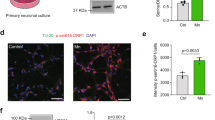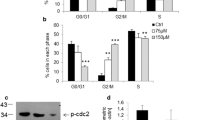Abstract
Acrylamide and carbon disulfide produce central-peripheral distal axonopathy in experimental animals and humans. The main feature of this disease is the focal swellings containing neurofilaments in distal axons, followed by nerve degeneration beyond these swellings. We studied the possible role of tubulin assembly kinetics in this disease. The rats were either administered acrylamide (50 mg/kg, ip, saline) or exposed to carbon disulfide (700 ppm, 9h) via inhalation for 12 and 15 d, respectively. Tubulin, purified from both acrylamide-(10.37±0.3 vs 11.3±0.15) and carbon disulfide-treated (9.72±0.5 vs 11.18±0.25) rat brains showed increase inV max (OD/min × 103) of its polymerization. However, only acrylamide treatment showed a decrease in time toV max, when brain supernatant was used for tubulin polymerization. In vitro addition of acrylamide (0.1–1 mM) to bovine brain tubulin also showed a decrease in time toV max (16–21%) of its polymerization. Carbon disulfide treatment of rats, on the other hand, showed a decrease in MAP-2 and an increase in a 120-kDa peptide concentration. The latter showed immunoreactivity with anti-MAP-2. The increase in the rate of tubulin polymerization by acrylamide and carbon disulfide treatment may alter the rate of transport of axonal consituents, including neurofilament, and contribute toward their accumulation in the focal swellings observed in this neuropathy.
Similar content being viewed by others
Abbreviations
- DFP:
-
diisopropyl phosphorofluoridate
- DTT:
-
dithiothreitol
- DMHD:
-
3,4-dimethyl-2,5-hexanedione
- EGTA:
-
ethyleneglycol-bis(β-aminoethyl ether),N, N, N′, N′-tetraacetic acid
- EDTA:
-
ethylenediaminetetraacetic acid
- GTP:
-
guanosine-5′-triphosphate
- 2,5-HD:
-
2,5-hexanedione
- IDPN:
-
β, β′-imino-3-dipropionitrile
- PMSF:
-
phenylmethylsulfonyl fluoride
- PIPES:
-
piperazine-N,N′-bis[2-ethanesulfonic acid]
- PAGE:
-
polyacrylamilde gel electrophoresis
- SDS:
-
sodium dodecyl sulfate
- TEMED:
-
N,N,N′,N′-tetramethylethylenediamine
References
Abou-Donia M. B., Ibrahim S. M., Corcoran J. J., Lack L., Friedman M. A., and Lapadula D. M. (1993) Neurotoxicity of glycidamide, an acrylamide metabolite, following intraperitoneal injection in rats.J. Toxicol. Environ. Health 39, 447–464.
Amarnath V., Anthony D. C., Valentine W. M., and Graham D. G. (1991) The molecular mechanism of the carbon disulfide mediated cross-linking of proteins.Chem. Res. Toxicol. 4, 148–150.
Anthony D. C., Giangaspero F., and Graham D. G. (1983) The spatio-temporal pattern of axonopathy associated with the neurotoxicity of 3,4-dimethyl-2,5-hexanedione in the rat.J. Neuropathol. Exp. Neurol. 42, 548–560.
Black M. M. and Baas P. W. (1989) The basis of polarity in neurons.Trends Neurosci. 12, 211–214.
Boekelheide K. (1987) 2,5-hexanedione alters microtubule assembly. I. Testicular atrophy, not nervous system toxicity, correlates with enhanced tubulin polymerization.Toxicol. Appl. Pharmacol. 88, 370–382.
Bradford M. M. (1976) A rapid and sensitive method for the quantitation of microgram quantities of protein utilizing the principle of protein-dye binding.Anal. Biochem. 72, 248–254.
Carrington C. D. and Abou-Donia M. B. (1985) Characterization of [3H]diisopropyl phosphorofluoridate-binding proteins in hen brain.Biochem. J. 228, 537–544.
Carrington C. D., Lapadula D. M., Dulak L., Friedman M., and Abou-Donia M. B. (1991)In vivo binding of [14C]acrylamide to proteins in the mouse nervous system.Neurochem. Int. 18, 191–197.
Chauhan N. B., Spencer P. S. and Sabri M. I. (1993) Effect of acrylamide on the distribution of microtubule-associated proteins (MAP1 and MAP2) in selected regions of rat brain.Mol. Chem. Neuropathol. 18, 225–245.
Clerici W. J. and Fechter L. D. (1991) Effects of chronic disulfide inhalation on sensory and motor function in the rat.Neurotoxicol. Teratol. 13, 249–255.
Dustin P. (1984)Microtubules. Springer-Verlag, New York.
Edwards P. M., Sporel-Ozakat E., and Gispen W. H. (1991) Neurotoxic acrylamide and neurotrophic melanocortin peptides—can contrasting actions provide clues about modes of action?Neuropathol. Appl. Neurobiol. 17, 91–104.
Fliegner K. H. and Liem R. K. H. (1991) Cellular and molecular biology of neuronal intermediate filaments.Inter. Rev. Cytol. 131, 109–167.
Funk K. A., Henderson J. D., Liu C.-H., Higgins R. J., and Wilson B. W. (1994) Neuropathology of organophosphorus-induced delayed neuropathy (OPIDN) in young chicks.Arch. Toxicol. 68, 308–316.
Griffin J. W., Fahnestock K. E., Price D. L., and Cork L. C. (1983a) Cytoskeletal disorganization induced by local application of IDPN and 2,5-hexanedione.Ann. Neurol. 14, 55–61.
Griffin J. W., Fahnestock K. E., Price D. L., and Hoffman P. N. (1983b) Microtubule-neurofilament segregation produced by β,β′-iminodipropionitrile: Evidence for the association of fast axonal transport with microtubules.J. Neurosci. 3, 557–566.
Gupta R. P. and Abou-Donia M. B. (1994)In vivo andin vitro effects of diisopropyl phosphorofluoridate (DFP) on the rate of hen brain tubulin polymerization.Neurochem. Res. 19, 435–444.
Hashimoto K., Kurosaka Y., Tanii H., and Hayashi M. (1988) Immunochemical studies of acrylamide-associated neuropathology.Toxicology 49, 65–69.
Hatzfeld M. and Weber K. (1992) A synthetic peptide representing the consensus sequence motif at the carboxy-terminal end of the rod domain inhibits intermediate filament assembly and disassembles preformed filaments.J. Cell Biol. 116, 157–166.
Hirokawa N. (1982) Cross-linker system between neurofilaments, microtubules, and membrane organelles in frog axons revealed by the quick-freeze, deepetching method.J. Cell Biol. 94, 129–142.
Huber G. and Schuler A. (1991) Characterization of a new 120 kDa microtubule-associated protein (MAP) of rat brain.Neurosci. Lett. 128, 221–225.
Iqbal K., Grundke-Iqbal I., Tanweer Z., Merz P. A., Wen G. Y., Shaikh S., Wisniewski H. M., Alafuzoff I., and Winblad B. (1986) Defective brain microtubule assembly in Alzheimer's disease.Lancet 11, 421–426.
Laemmli U. K. (1970) Cleavage of structural proteins during assembly of the head of the bacteriophage T4.Nature 277, 680–685.
Lapadula D. M., Bowe M., Carrington C. D., Dulak L., Friedman M., and Abou-Donia M. B. (1989)In vitro binding of [14C]acrylamide to neurofilament and microtubule proteins of rats.Brain Res. 481, 157–161.
Melki R., Kerjan P., Waller J.-P., Carlier M.-F., and Pantaloni D. (1991) Interaction of microtubule-associated proteins with microtubules: Yeast lysyland valyl-tRNA synthetases and tau 218–235 synthetic peptide as model systems.Biochemistry 30, 11,536–11,545.
Minana M.-D., Felipo V. and Grisolia S. (1989) Assembly and disassembly of brain tubulin is affected by high ammonia levels.Neurochem. Res. 14, 235–238.
Oteiza P. I., Golub M. S., Gershwin M. E., Donald J. M., and Keen C. L. (1989) The influence of high dietary aluminum on brain microtubule polymerization in mice.Toxicol. Lett. 47, 279–285.
Pappolla, M., Penton R., Weiss H. S., Miller C. H. Jr., Sahenk Z., Autilio-Gambetti L., and Gambetti P. (1987) Carbon disulfide axonopathy. Another experimental model characterized by acceleration of neurofilament transport and distinct changes of axonal size.Brain Res. 424, 272–280.
Peterson G. L. (1977) A simplification of the protein assay method of Lowry et al. which is more generally applicable.Anal. Biochem. 83, 346–356.
Reagan K. E., Wilmarth K. R., Friedman M., and Abou-Donia M. B. (1994) Acrylamide increasesin vitro calcium and calmodulin-dependent kinase-mediated phosphorylation of rat brain and spinal cord neurofilament proteins.Neurochem. Int. 25, 133–143.
Rosenthal S. and Kaufman S. (1974) Vincristine neurotoxicity.,Ann. Intern. Med. 80, 733–737.
Sayre L. M., Autilio-Gambetti L., and Gambetti P. (1985) Pathogenesis of experimental giant neurofilamentous axonopathies: A unified hypothesis based on chemical modification of neurofilaments.Brain Res Rev. 10, 69–83.
Seppalainen A. M. and Haltia M. (1980) Carbon disulfide, inExperimental and Clinical Neurotoxicology (Spencer P. S. and Schaumburg H. H., eds.), William and Wilkins, Baltimore, pp. 356–373.
Sickles D. W. (1989) Toxic neurofilamentous axonopathies and fast anterograde axonal transport. I. The effects of single doses of acrylamide on the rate and capacity of transport.Neurotoxicology 10, 91–102.
US Environmental Protection Agency, Office of Drinking Water, Washington, DC (July 1987) TR-832-104A. Final draft for the drinking water criteria document on acrylamide.
US Environmental Protection Agency, Office of Toxic Substances, Washington, DC (March 1988) Preliminary Assessment of Health Risks from Exposure to Acrylamide.
Vallano M. L., Goldenring J. R., Lasher R. S., and DeLorenzo R. J. (1986) Association of calcium/calmodulin-dependent kinase with cytoskeletal preparations: Phosphorylation of tubulin, neurofilament, and microtubule-associated proteins. Ann. NYAcad. Sci. 466, 357–374.
Vallee R. B. and Shpetner H. S. (1990) Motor proteins of cytoplasmic microtubules.Ann. Rev. Biochem. 59, 909–932.
Weiss H. D., Walker M. D., and Wiernik P. H. (1974) Neurotoxicity of commonly used antineoplastic agents.New Engl. J. Med. 291, 75–81.
Wilmarth K. R., Viana M. E., and Abou-Donia M. B. (1993) Carbon disulfide (CS2) inhalation increases Ca2+/calmodulin-dependent phosphorylation of cytoskeletal proteins in the rat central nervous system.Brain Res. 628, 293–300.
Author information
Authors and Affiliations
Rights and permissions
About this article
Cite this article
Gupta, R.P., Abou-Donia, M.B. Acrylamide and carbon disulfide treatments increase the rate of rat brain tubulin polymerization. Molecular and Chemical Neuropathology 30, 223–237 (1997). https://doi.org/10.1007/BF02815100
Received:
Revised:
Accepted:
Issue Date:
DOI: https://doi.org/10.1007/BF02815100




